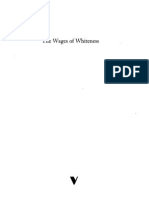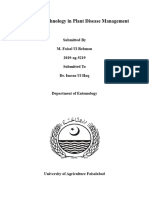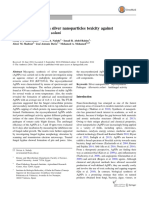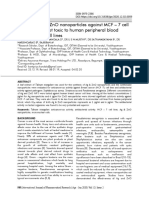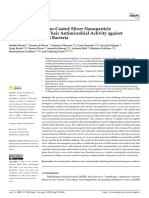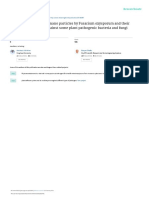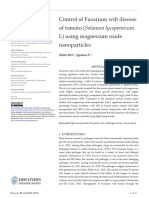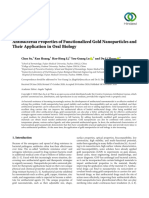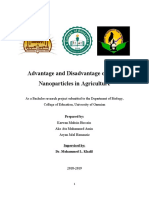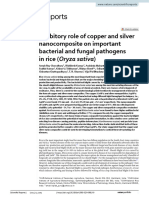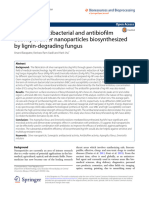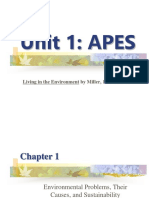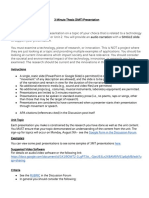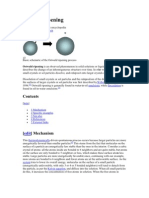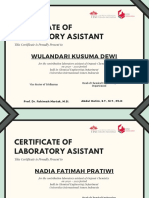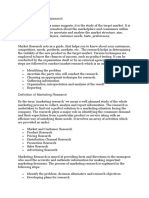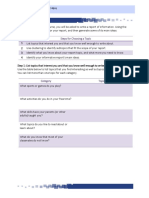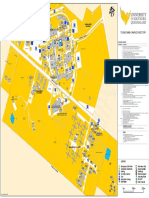0 ratings0% found this document useful (0 votes)
25 viewsFungal Genomics & Biology: Nanoplatforms For Plant Pathogenic Fungi Management
Fungal Genomics & Biology: Nanoplatforms For Plant Pathogenic Fungi Management
Uploaded by
Nguyễn Khắc HảiPlant pathologists are striving to develop a successful solution for protecting food and agricultural products from bacteria, fungal and viral agents. New technology such as nanoscale platforms, biological sensors, miniature detection devices and nano sensors could play a signifcant role in the future pathogen detection and disease management. A number of nanotechnologies can improve existing crop control protocols in the short to medium term.
Copyright:
© All Rights Reserved
Available Formats
Download as PDF, TXT or read online from Scribd
Fungal Genomics & Biology: Nanoplatforms For Plant Pathogenic Fungi Management
Fungal Genomics & Biology: Nanoplatforms For Plant Pathogenic Fungi Management
Uploaded by
Nguyễn Khắc Hải0 ratings0% found this document useful (0 votes)
25 views2 pagesPlant pathologists are striving to develop a successful solution for protecting food and agricultural products from bacteria, fungal and viral agents. New technology such as nanoscale platforms, biological sensors, miniature detection devices and nano sensors could play a signifcant role in the future pathogen detection and disease management. A number of nanotechnologies can improve existing crop control protocols in the short to medium term.
Original Title
2165-8056-2-e107
Copyright
© © All Rights Reserved
Available Formats
PDF, TXT or read online from Scribd
Share this document
Did you find this document useful?
Is this content inappropriate?
Plant pathologists are striving to develop a successful solution for protecting food and agricultural products from bacteria, fungal and viral agents. New technology such as nanoscale platforms, biological sensors, miniature detection devices and nano sensors could play a signifcant role in the future pathogen detection and disease management. A number of nanotechnologies can improve existing crop control protocols in the short to medium term.
Copyright:
© All Rights Reserved
Available Formats
Download as PDF, TXT or read online from Scribd
Download as pdf or txt
0 ratings0% found this document useful (0 votes)
25 views2 pagesFungal Genomics & Biology: Nanoplatforms For Plant Pathogenic Fungi Management
Fungal Genomics & Biology: Nanoplatforms For Plant Pathogenic Fungi Management
Uploaded by
Nguyễn Khắc HảiPlant pathologists are striving to develop a successful solution for protecting food and agricultural products from bacteria, fungal and viral agents. New technology such as nanoscale platforms, biological sensors, miniature detection devices and nano sensors could play a signifcant role in the future pathogen detection and disease management. A number of nanotechnologies can improve existing crop control protocols in the short to medium term.
Copyright:
© All Rights Reserved
Available Formats
Download as PDF, TXT or read online from Scribd
Download as pdf or txt
You are on page 1of 2
Volume 2 Issue 2 1000e107
Fungal Genom Biol
ISSN: 2165-8056 FGB, an open access journal
Open Access Editorial
Fungal Genomics & Biology
Abd-Elsalam, Fungal Genom Biol 2013, 2:2
http://dx.doi.org/10.4172/2165-8056.1000e107
Nanoplatforms for Plant Pathogenic Fungi Management
Kamel A. Abd-Elsalam*
Plant Pathology Research Institute, Agricultural Research Center, Egypt
*Corresponding author: Kamel A. Abd-Elsalam, Plant Pathology Research
Institute, Agricultural Research Center, Egypt, E-mail: abd-elsalam.k.a@post.com
Received October 17, 2012; Accepted October 19, 2012; Published October 26,
2012
Citation: Abd-Elsalam KA (2013) Nanoplatforms for Plant Pathogenic Fungi
Management. Fungal Genom Biol 2: e107. doi:10.4172/2165-8056.1000e107
Copyright: 2013 Abd-Elsalam KA. This is an open-access article distributed
under the terms of the Creative Commons Attribution License, which permits
unrestricted use, distribution, and reproduction in any medium, provided the
original author and source are credited.
Plant pathologists are striving to develop a successful solution for
protecting food and agricultural products from bacteria, fungal and
viral agents. New technology such as nanoscale platforms, biological
sensors, miniature detection devices and nano sensors could play
a signifcant role in the future pathogen detection and disease
management. Nano grower-friendly methods need to be integrated
into present practices, and be readily useable for protecting crops and
avoiding crop loss to pests and disease.
A number of nanotechnologies can improve existing crop
control protocols in the short to medium term [1]. Te applications
of nonmaterials to the agricultural are also commanding attention.
Nanotechnology applications are being developed and present
signifcant opportunities to more profciently and unhazardously treat
fungicides, herbicides and fertilizers, by controlling precisely when and
where they are released [2]. For example, an eco-friendly fungicide is
under development that uses nanomaterials to liberate its pathogen
killing properties, only when it is inside the targeted pathogen [3].
Control of food crop diseases is essential. Recently, efort has been
made to develop harmless management methods that pose fewer
hazards to humans and animals, and have focused on overcoming lack
of synthetic fungicides.
Te antifungal efect of silver nanoparticles (NPs) has received only
minor attention and with only a few published articles on this topic
[4]. Since, silver displays various modes of inhibitory action to plant
pathogens, it may be used for controlling various plant pathogens in
a moderately safer way, compared to synthetic fungicides [5]. Silver
nanoparticles have strong potential as an antimycotic activity against
fungi of grey mold, Botrytis cinerea [6]. Kirby-Bauer disc difusion
protocol was used to evaluate the communal efect of fuconazole
and silver nanoparticles for their antifungal activity against three
fungal pathogens, Phoma glomerata, Phoma herbarum, and Fusarium
semitectum [7]. Ag
2
S nanocrystals on amorphous silica particles show
antifungal activity against A. niger. Te potential biocidal efcacy of
ZnO and ZnTiO
3
nanopowders against the fungus A. niger was assessed
[8]. ZnTiO
3
nanopowder showed higher growth inhibition efciency
than ZnO.
Silver ions and nanoparticles were evaluated to determine the
antifungal action on Bipolaris sorokiniana and Magnaporthe grisea. Te
in vitro and in vivo evaluations of both silver ions and nanoparticles
decrease disease development of phytopathogenic fungi [9]. Min et al.
[10] evaluated the antifungal efects of silver nanoparticles, especially
on sclerotia forming phytopathogenic fungi. Te antifungal activity
of silver nanoparticles assessed against flamentous ambrosia fungi in
South Korea [11]. Te efect of silver nanoparticles on plant pathogenic
spores of Fusarium culmorum was studied by Kasprowicz et al. [12].
Te silver nanoparticles also found to exhibit antifungal activity against
Fusarium oxysporum [13]. Silver nanoparticles strikingly decreased the
number of germinating fragments and sprout length, relative to the
control. Zinc oxide nanoparticles inhibited the fungal growth of Botrytis
cinerea by infuencing cellular functions, which caused deformation
in mycelial mats. In addition, Zinc oxide NPs inhibited the growth of
conidiophores and conidia of Penicillium expansum, which fnally led
to the death of fungal mats. Te mycosynthesized silver nanoparticles
may be non-toxic to people and animals, than synthetic fungicides.
Moreover, in addition to the toxicity that nanoparticles may cause on
algae, plants and fungi, they may also have some positive efects.
Te antifungal activity of the silver nanoparticles was evaluated on
the phytopathogen Colletotrichum gloeosporioides, which is responsible
for anthracnose in a wide range of fruits. Silver nanoparticles signifcantly
reduced the mycelia growth of Colletotrichum gloeosporioides in a dose-
dependent manner [14]. Antifungal properties of silver nanoparticles,
silver ions, acrylate paint and cotton fabric impregnated with silver
nanoparticles were assessed against A. niger, Aureobasidium pullulans
and Penicillium phoeniceum [15]. Bioassay of elemental and nano-
sulphur against Aspergillus niger showed that nanosulfur was more
efcient than its elemental structure [3].
Smart delivery system has a huge potential for improving efciency
of fungicides in agriculture systems. Development of these technologies
in plant protection would allow their use in crop protection [16].
Diferent concentrations of nanosized silica-silver were evaluated
for growth inhibition of phytopathogenic bacteria and fungi; and
it was found that 100% growth inhibition of Pseudomonas syringae
and Xanthomonas compestris pv. vesicatoria occurred at 100 ppm.
Magnaporthe grisea, Botrytis cinerea, Colletotrichum gloeosporioides,
Pythium ultimum, and Rhizoctonia solani, showed 100% growth
inhibition at 10 ppm of the nanosized silica-silver [5]. Antimycotic
activity of some nanoparticles of silver has also been reported on
some fungi like wood rotting fungi, Fusarium species and other
phytopathogenic fungi [17].
Nano-dispersed formulations can be prepared in a simple cost-
efective manner,and are suited for developing new forms of fungicidal
materials. Tere are some records of the nano-sized or nano-
formulation for agrochemicals development of existing pesticides,
fungicides, plant, soil and seed treatments. Syngentas Banner MAXX
is a systemic fungicide ofering broad-spectrum disease control in
turf and ornamental plants. It is commercialized as a micro emulsion
concentrate formulation, providing excellent tank mix compatibility
and stability.
Resistance in plants would help in management of above
mentioned agents to overcome the problem of economic loss.
Nanoparticles mediated plant transformation has the potential for
genetic modifcation of plants for further improvement. In particular,
application of nanoparticles technology in agriculture targets specifc
Citation: Abd-Elsalam KA (2013) Nanoplatforms for Plant Pathogenic Fungi Management. Fungal Genom Biol 2: e107. doi:10.4172/2165-
8056.1000e107
Page 2 of 2
Volume 2 Issue 2 1000e107
Fungal Genom Biol
ISSN: 2165-8056 FGB, an open access journal
problems in plant protection, pathogen detection, plantpathogen
interactions and ofers new methods for plant disease management
[18]. For example, introduction of resistance genes in plant cells using
nanotechnological approaches may lead to development of resistant
varieties, which will minimize expenses on agrochemicals required
for disease control. Presently, research is being carried out by using
nanosensors to improve pathogen detection methods and plant disease
forecasting in crop systems. Nanosensors can be linked to a GPS system
for real-time monitoring of disease, and distributed throughout the feld
to monitor soil conditions and crop health [19]. Nano-Phytopathology
can be applied as a tool to understand plant-pathogen interactions,
which will provide new methods for crop protection.
References
1. Prez-de-Luque A, Rubiales D (2009) Nanotechnology for parasitic plant
control. Pest Manag Sci 65: 540-545.
2. Li ZZ, Chen JF, Liu F, Liu AQ, Wang Q, et al. (2007) Study of UV-shielding
properties of novel porous hollow silica nanoparticle carriers for avermectin.
Pest Manag Sci 63: 241-246.
3. Choudhury SR, Nair KK, Kumar R, Gogoi R, Srivastava C, et al.
(2010) Nanosulfur: A potent fungicide against food pathogen, Aspergillus niger.
AIP Conf Proc 1276: 154-157.
4. Roe D, Karandikar B, Bonn-Savage N, Gibbins B, Roullet JB (2008) Antimicrobial
surface functionalization of plastic catheters by silver nanoparticles. J
Antimicrob Chemother 61: 869-876.
5. Park HJ, Kim SH, Kim HJ, Choi SH (2006) A new composition of nanosized
silica-silver for control of various plant diseases. Plant Pathol J 22: 295-302.
6. Oh SD, Lee S, Choi SH, Lee IS, Lee YM, et al. (2006) Synthesis of Ag and
Ag-SiO2 nanoparticles by -irradiation and their antibacterial and antifungal
effciency against Salmonella enteric serovar Typhimurium and Botrytis
cinerea. Colloids and Surfaces A: Physicochem Eng Aspects 275: 228-233.
7. Gajbhiye M, Kesharwani J, Ingle A, Gade A, Rai M (2009). Fungus-mediated
synthesis of silver nanoparticles and their activity against pathogenic fungi in
combination with fuconazole. Nanomedicine 5: 382-386.
8. Ruffolo SA, La Russa MF, Malagodi M, Oliviero Rossi C, Palermo AM, et al.
(2010) ZnO and ZnTiO
3
nanopowders for antimicrobial stone coating. Appl
Phys A 100: 829-834.
9. Jo YK, Kim BH, Jung G (2009) Antifungal activity of silver ions and nanoparticles
on phytopathogenic fungi. Plant Dis 93:1037-1043.
10. Min JS, Kim KS, Kim SW, Jung JH, Lamsal K, et al. (2009) Effects of Colloidal
Silver Nanoparticles on Sclerotium-Forming Phytopathogenic Fungi. Plant
Pathol J 25: 376-380.
11. Kim SW, Kim KS, Lamsal K, Kim YJ, Kim SB, et al. (2009) An in vitro study of
the antifungal effect of silver nanoparticles on oak wilt pathogen Raffaelea sp.
J Microbiol Biotechnol 19: 760-764.
12. Kasprowicz MJ, Kozio M, Gorczyca A (2010) The effect of silver nanoparticles
on phytopathogenic spores of Fusarium culmorum. Can J Microbiol 56: 247-
253.
13. Musarrat J, Dwivedi S, Singh BR, Al-Khedhairy AA, Azam A, et al.
(2010) Production of antimicrobial silver nanoparticles in water extracts of the
fungus Amylomyces rouxii strain KSU-09. Bioresour Technol 101: 8772-8776.
14. Aguilar-Mndez MA, Martn-Martnez ES, Ortega-Arroyo L, Cobin-Portillo
G, Snchez-Espndola E (2011) Synthesis and characterization of silver
nanoparticles: effect on phytopathogen Colletotrichum gloesporioides.J
Nanopart Res13: 2525-2532.
15. Khaydarov RR, Khaydarov RA, Evgrafova S, Estrin Y (2011) Using silver
nanoparticles as an antimicrobial agent. NATO Science for Peace and Security
Series A: Chemistry and Biology, 169-177.
16. Bouwmeester H, Dekkers S, Noordam MY, Hagens WI, Bulder AS, et al. (2009)
Review of health safety aspects of nanotechnologies in food production. Regul
Toxicol Pharmacol 53: 52-62.
17. Wani AH, Shah MA (2012) A unique and profound effect of MgO and
ZnO nanoparticles on some plant pathogenic fungi. Journal of Applied
Pharmaceutical Science 02: 40-44.
18. Mahendra R, Shivaji D, Aniket G, Kamel-Abd-Elsalam (2012) Strategic
nanoparticle-mediated gene transfer in plants and animals - a novel approach.
Curr Nanosci 8:170-179.
19. Sharon M, Choudhary AK, Kumar R (2010) Nanotechnology in agricultural
diseases and food safety. Journal of Phytology 2: 83-92.
Submit your next manuscript and get advantages of OMICS
Group submissions
Unique features:
User friendly/feasible website-translation of your paper to 50 worlds leading languages
Audio Version of published paper
Digital articles to share and explore
Special features:
250 Open Access Journals
20,000 editorial team
21 days rapid review process
Quality and quick editorial, review and publication processing
Indexing at PubMed (partial), Scopus, EBSCO, Index Copernicus and Google Scholar etc
Sharing Option: Social Networking Enabled
Authors, Reviewers and Editors rewarded with online Scientifc Credits
Better discount for your subsequent articles
Submit your manuscript at: http://www.omicsonline.org/submission
Citation: Abd-Elsalam KA (2013) Nanoplatforms for Plant Pathogenic Fungi
Management. Fungal Genom Biol 2: e107. doi:10.4172/2165-8056.1000e107
You might also like
- Neuro-Associative Conditioning: Programing Your Trading Mind'Document21 pagesNeuro-Associative Conditioning: Programing Your Trading Mind'ediNo ratings yet
- PLC Training AssignmentsDocument2 pagesPLC Training Assignmentsnehal100% (1)
- The Wages of Whiteness (David Roediger)Document222 pagesThe Wages of Whiteness (David Roediger)asnoel100% (8)
- An in Vitro Study of The Antifungal Acti PDFDocument4 pagesAn in Vitro Study of The Antifungal Acti PDFM Fzn LbsNo ratings yet
- Research Article: Grewia Tenax-Mediated Silver Nanoparticles As EfficientDocument14 pagesResearch Article: Grewia Tenax-Mediated Silver Nanoparticles As EfficientVĩnh ThuầnNo ratings yet
- Use of Nanotechnology in Plant Disease ManagementDocument5 pagesUse of Nanotechnology in Plant Disease Managementmuhammadawaismanzoor366No ratings yet
- Antifungal Effects of Silver Nanoparticles (Agnps) Against Various Plant Pathogenic FungiDocument6 pagesAntifungal Effects of Silver Nanoparticles (Agnps) Against Various Plant Pathogenic FungiAbhishek KatagiNo ratings yet
- DDMMYYDocument6 pagesDDMMYYmuhammadawaismanzoor366No ratings yet
- MoleculesDocument14 pagesMoleculesVũ Phi YếnNo ratings yet
- Green NanotechnologyDocument7 pagesGreen Nanotechnologyasadalijanjua.0003No ratings yet
- Inhibition Effects of Silver Nanoparticles Against Powdery Mildews On Cucumber and PumpkinDocument8 pagesInhibition Effects of Silver Nanoparticles Against Powdery Mildews On Cucumber and Pumpkinswamykumar934No ratings yet
- tmpBA15 TMPDocument12 pagestmpBA15 TMPFrontiersNo ratings yet
- Tmpa936 TMPDocument12 pagesTmpa936 TMPFrontiersNo ratings yet
- Cancer Therapy PaperDocument13 pagesCancer Therapy Paperkanti priya KondalaNo ratings yet
- Fusarium As A Novel Fungus For The Synthesis of NaDocument24 pagesFusarium As A Novel Fungus For The Synthesis of Navampire diariesNo ratings yet
- Green Synthesis of Clitoria and SolanumDocument9 pagesGreen Synthesis of Clitoria and SolanumDeepaNo ratings yet
- Abdelghany2018 Article RecentAdvancesInGreenSynthesisDocument12 pagesAbdelghany2018 Article RecentAdvancesInGreenSynthesisAbderahim BoutemedjetNo ratings yet
- Preparation and Evaluation of Zeolite Nanoparticles As A Delivery System For Helicoverpa Armigera NucleopolyhedrovirusDocument11 pagesPreparation and Evaluation of Zeolite Nanoparticles As A Delivery System For Helicoverpa Armigera NucleopolyhedrovirusLufia CeruleanNo ratings yet
- Evaluation of Using Nanomaterial in Tissue Culture Media and Biological ActivityDocument4 pagesEvaluation of Using Nanomaterial in Tissue Culture Media and Biological ActivityJumrah ArifNo ratings yet
- Shinde Et Al. - 2021 - Synthesis of Chitosan Coated Silver Nanoparticle Bioconjugates and Their Antimicrobial Activity Against MultidDocument18 pagesShinde Et Al. - 2021 - Synthesis of Chitosan Coated Silver Nanoparticle Bioconjugates and Their Antimicrobial Activity Against MultidRevathi RajagopalNo ratings yet
- Phyto-Synthesis of Silver Nanoscale Particles Using Morinda Citrifolia L. and ItsDocument6 pagesPhyto-Synthesis of Silver Nanoscale Particles Using Morinda Citrifolia L. and ItsBira AdrianaNo ratings yet
- Applsci 10 05054Document15 pagesApplsci 10 05054amlmahmoudgad124No ratings yet
- Bioproduction of Silver-Nano Particles by Fusarium Oxysporum and Their Antimicrobial Activity Against Some Plant Pathogenic Bacteria and FungiDocument7 pagesBioproduction of Silver-Nano Particles by Fusarium Oxysporum and Their Antimicrobial Activity Against Some Plant Pathogenic Bacteria and Fungiprabhakar beeravelliNo ratings yet
- PLPT-504: Online Project On, Basic Concept in Laboratory TechniquesDocument13 pagesPLPT-504: Online Project On, Basic Concept in Laboratory Techniquessunayana debNo ratings yet
- Fungus in Research ToolsDocument3 pagesFungus in Research ToolsIdeal Stationery and ComputerNo ratings yet
- Nanotechnology Has Revolutionized A Wide Range of IndustriesDocument2 pagesNanotechnology Has Revolutionized A Wide Range of IndustriesZhinuk RockzzNo ratings yet
- Arab Et Al. 2014Document8 pagesArab Et Al. 2014argos1301No ratings yet
- Discovery: Control of Fusarium Wilt Disease of Tomato (Solanum Lycopersicum. L) Using Magnesium Oxide NanoparticlesDocument12 pagesDiscovery: Control of Fusarium Wilt Disease of Tomato (Solanum Lycopersicum. L) Using Magnesium Oxide Nanoparticlesamlmahmoudgad124No ratings yet
- molecules-27-00224-with-coverDocument19 pagesmolecules-27-00224-with-coverAli Athafah TomahNo ratings yet
- Anti Biofilm Effects of Gold and Silver Nanoparticles Synthesized by The Rhodiola Rosea Rhizome ExtractsDocument15 pagesAnti Biofilm Effects of Gold and Silver Nanoparticles Synthesized by The Rhodiola Rosea Rhizome ExtractsJibraan MukNo ratings yet
- Biosíntesis de Nanopartículas de Plata Con Actividad Antimicrobiana Por Pseudomonas Aeruginosa AmbientalDocument13 pagesBiosíntesis de Nanopartículas de Plata Con Actividad Antimicrobiana Por Pseudomonas Aeruginosa AmbientalemanuelagustinriveroNo ratings yet
- Green Synthesis of Metallic Nanoparticles and Its Potential To Enhance Production of Agricultural Crops: A ReviewDocument8 pagesGreen Synthesis of Metallic Nanoparticles and Its Potential To Enhance Production of Agricultural Crops: A ReviewSuhas RamachandraNo ratings yet
- Antimicrobial and Antibiotic Properties of Silver Nanoparticles (AgNPs)Document25 pagesAntimicrobial and Antibiotic Properties of Silver Nanoparticles (AgNPs)arubackup2003No ratings yet
- Eco-Friendly Nano-Pesticides A Comprehensive Review of Their Applications andDocument18 pagesEco-Friendly Nano-Pesticides A Comprehensive Review of Their Applications and120 SecondsNo ratings yet
- Nigrum and Study of Its Antibacterial Effect Against Common Nosocomial PathogensDocument22 pagesNigrum and Study of Its Antibacterial Effect Against Common Nosocomial Pathogensosama almomaniNo ratings yet
- Journal of Phytopathology - 2021 - González Merino - Antifungal Activity of Zinc Oxide Nanoparticles in FusariumDocument12 pagesJournal of Phytopathology - 2021 - González Merino - Antifungal Activity of Zinc Oxide Nanoparticles in Fusariumamlmahmoudgad124No ratings yet
- Gold NanoparticlesDocument13 pagesGold NanoparticlesDr. Solomon Omwoma LugasNo ratings yet
- Microorganisms 10 00791 v3Document15 pagesMicroorganisms 10 00791 v3Hvzem MohammedNo ratings yet
- Advantage and Disadvantage of Using Nanoparticles in AgricultureDocument13 pagesAdvantage and Disadvantage of Using Nanoparticles in AgricultureAmjadRashidNo ratings yet
- 1 Coatings-12-01864-V2 (2) - CompressedDocument15 pages1 Coatings-12-01864-V2 (2) - CompressedsinouvassaneNo ratings yet
- Synthesis, Characterization and Antifungal Activity of Chemically and Fungal Produced Silver NanoparticlesDocument26 pagesSynthesis, Characterization and Antifungal Activity of Chemically and Fungal Produced Silver NanoparticlesAndrea CalderaNo ratings yet
- Ijms 22 07202Document21 pagesIjms 22 07202Anisa RatnasariNo ratings yet
- 0352 49061733231S PDFDocument10 pages0352 49061733231S PDFDaniel MerelNo ratings yet
- Inhibitory Role of Copper and Silver Nanocomposite On Impotant Bacterial and Ungal Pathogens of RiceDocument14 pagesInhibitory Role of Copper and Silver Nanocomposite On Impotant Bacterial and Ungal Pathogens of RiceArnab Roy ChowdhuryNo ratings yet
- Insects 14 00091Document11 pagesInsects 14 00091Rahul JaganNo ratings yet
- 2021 Silver Nanoparticles Biosynthesized With Spruce Bark Extract - A Molecular Aggregate With Antifungal Activity Against Candida SpeciesDocument14 pages2021 Silver Nanoparticles Biosynthesized With Spruce Bark Extract - A Molecular Aggregate With Antifungal Activity Against Candida SpeciesAnca MareNo ratings yet
- Antimicrobial Activity of Silver Nanoparticles SynDocument6 pagesAntimicrobial Activity of Silver Nanoparticles SynM Fzn LbsNo ratings yet
- 2023 - Plant-Derived Metallic Nanopesticides Against Storage PestsDocument10 pages2023 - Plant-Derived Metallic Nanopesticides Against Storage PestsSATYA27SINGHNo ratings yet
- Synergistic Antibacterial and Antibiofilm Activity of Silver Nanoparticles Biosynthesized by Lignin-Degrading FungusDocument13 pagesSynergistic Antibacterial and Antibiofilm Activity of Silver Nanoparticles Biosynthesized by Lignin-Degrading FungusRin ChanNo ratings yet
- Fungal Nanotechnology - Applications in Agriculture, Industry, and Medicine (PDFDrive)Document299 pagesFungal Nanotechnology - Applications in Agriculture, Industry, and Medicine (PDFDrive)golden.boy.on.jobNo ratings yet
- Antifungal Activity of Silver Ions and Nanoparticles On Phytopathogenic FungiDocument7 pagesAntifungal Activity of Silver Ions and Nanoparticles On Phytopathogenic FungiM Fzn LbsNo ratings yet
- Bacteria-Mediated Green Synthesis of Silver Nanoparticles and Their Antifungal Potentials Against Aspergillus Flavus - PLOS ONEDocument19 pagesBacteria-Mediated Green Synthesis of Silver Nanoparticles and Their Antifungal Potentials Against Aspergillus Flavus - PLOS ONEshaarifhamzaNo ratings yet
- Application of Broad-Spectrum of Marine Streptomyces Albidoflavus As Biofungicide and Plant Growth Promoting of Tomato DiseasesDocument7 pagesApplication of Broad-Spectrum of Marine Streptomyces Albidoflavus As Biofungicide and Plant Growth Promoting of Tomato DiseasesREYES ALEJANDRO GARNICA ZAPATANo ratings yet
- Nano ParticlesDocument13 pagesNano ParticlesaathiraNo ratings yet
- 13586-Article Text-1078385-1-10-20230328Document7 pages13586-Article Text-1078385-1-10-20230328SitiNo ratings yet
- Antagonistic Activity of PGPRDocument6 pagesAntagonistic Activity of PGPRmounikad.openventioNo ratings yet
- Uji BiokimiaDocument10 pagesUji BiokimiaDandi SaputraNo ratings yet
- 1 s2.0 S2314808X17304530 MainDocument9 pages1 s2.0 S2314808X17304530 MainHagere EthiopiaNo ratings yet
- Assignment Biotch 405Document9 pagesAssignment Biotch 405Syed Ali HadiNo ratings yet
- Rajeshkumar 2019Document21 pagesRajeshkumar 2019yesuadrkruaNo ratings yet
- Nano BiotechnologyDocument14 pagesNano BiotechnologyiisatkashmeerNo ratings yet
- Nanoparticulas 2021Document13 pagesNanoparticulas 2021amlmahmoudgad124No ratings yet
- Nematodes and the Biological Control of Insect PestsFrom EverandNematodes and the Biological Control of Insect PestsRA BeddingRating: 1 out of 5 stars1/5 (1)
- Mathematical Model For Potassium Release From Polymer-Coated FertiliserDocument6 pagesMathematical Model For Potassium Release From Polymer-Coated FertiliserNguyễn Khắc HảiNo ratings yet
- Testing Methods For Fertilizers 2013Document370 pagesTesting Methods For Fertilizers 2013Azote85No ratings yet
- EuSalt AS007-2005 Potassium - Sodium Tetraphenylborate Volumetric MethodDocument5 pagesEuSalt AS007-2005 Potassium - Sodium Tetraphenylborate Volumetric MethodNguyễn Khắc HảiNo ratings yet
- Wescott Thai Rice PDFDocument9 pagesWescott Thai Rice PDFNguyễn Khắc HảiNo ratings yet
- Handbook of Water AnalysisDocument1 pageHandbook of Water AnalysisNguyễn Khắc HảiNo ratings yet
- Jasmine RiceDocument65 pagesJasmine RiceNguyễn Khắc HảiNo ratings yet
- Audit Sistem Informasi Akademik Menggunakan Framework Cobit 4.1 (Studi Kasus Ibi Darmajaya)Document21 pagesAudit Sistem Informasi Akademik Menggunakan Framework Cobit 4.1 (Studi Kasus Ibi Darmajaya)Andre MaulanaNo ratings yet
- Including The Other: Acknowledging Difference in Education, Language and HistoryDocument314 pagesIncluding The Other: Acknowledging Difference in Education, Language and HistoryAnonymous T5PT3UNo ratings yet
- Introduction To Chromatography: ComponentsDocument24 pagesIntroduction To Chromatography: ComponentsprabhatNo ratings yet
- Communication Process, Principles and EthicsDocument33 pagesCommunication Process, Principles and EthicsAlondra Borja67% (3)
- Unit 1: APES: Living in The Environment by Miller, 16 EditionDocument71 pagesUnit 1: APES: Living in The Environment by Miller, 16 EditionGrasielly CostaNo ratings yet
- BookDocument345 pagesBookJasdeep Singh KhuranaNo ratings yet
- Audio Narration SINGLE Slide: Google Form in The Discussion ForumDocument2 pagesAudio Narration SINGLE Slide: Google Form in The Discussion Forumfast sayanNo ratings yet
- PostgreSQL Dummy Database - Pizza Import (TXT File) (/i)Document3 pagesPostgreSQL Dummy Database - Pizza Import (TXT File) (/i)-andrew-No ratings yet
- Maritime Delimitation in The Black Sea Romania v. UkraineDocument7 pagesMaritime Delimitation in The Black Sea Romania v. UkraineMargreth MontejoNo ratings yet
- Guide Specification Walls, Interior, Wood or Metal Studs, Cementitious Backer Unit, Latex-Portland Cement Mortar, TCNA W244C-07Document5 pagesGuide Specification Walls, Interior, Wood or Metal Studs, Cementitious Backer Unit, Latex-Portland Cement Mortar, TCNA W244C-07alex_geus5080No ratings yet
- AITS-R Product and Operational Overview Rev04Document16 pagesAITS-R Product and Operational Overview Rev04Afrizal SetiawanNo ratings yet
- Lesson Plan Template: The Family Book by Todd ParrDocument2 pagesLesson Plan Template: The Family Book by Todd Parrrehus1illinoisNo ratings yet
- Oracle DBA Resume SampleDocument3 pagesOracle DBA Resume SampleIlyas AppsDBANo ratings yet
- Consultation Maori Hui Report Nov07Document135 pagesConsultation Maori Hui Report Nov07Kenny LynchNo ratings yet
- Kapra Trial Pit ReportDocument7 pagesKapra Trial Pit Reportbrahmanna penumakaNo ratings yet
- CDP Sriperumbudur14 PDFDocument432 pagesCDP Sriperumbudur14 PDFVaishali VasanNo ratings yet
- Ostwald RipeningDocument5 pagesOstwald RipeningNurdan AşarNo ratings yet
- Certificate of Laboratory Asistant: Wulandari Kusuma DewiDocument6 pagesCertificate of Laboratory Asistant: Wulandari Kusuma Dewidie lutionNo ratings yet
- Presentation:: My Dream SchoolDocument14 pagesPresentation:: My Dream SchoolAlexandru OlariNo ratings yet
- E14F05P09Document6 pagesE14F05P09Víctor RomeuNo ratings yet
- Market Research & Marketting ResearchDocument2 pagesMarket Research & Marketting ResearchGurprasad SinghNo ratings yet
- Science - Lesson On States of Matter For Pre K StudentsDocument30 pagesScience - Lesson On States of Matter For Pre K StudentsHồng Ngát PhíNo ratings yet
- Cambridge International AS & A Level: English Language 9093/41Document8 pagesCambridge International AS & A Level: English Language 9093/41reemNo ratings yet
- Liquid Liquid ExtractionDocument34 pagesLiquid Liquid ExtractionTubagusNo ratings yet
- Informative Topics: Steps For Choosing A TopicDocument3 pagesInformative Topics: Steps For Choosing A TopicPlaton MihaiNo ratings yet
- Toowoomba Map 20Document1 pageToowoomba Map 20kareemulllahNo ratings yet
- It Is A Mini ProjectDocument34 pagesIt Is A Mini ProjectMohit DixitNo ratings yet


